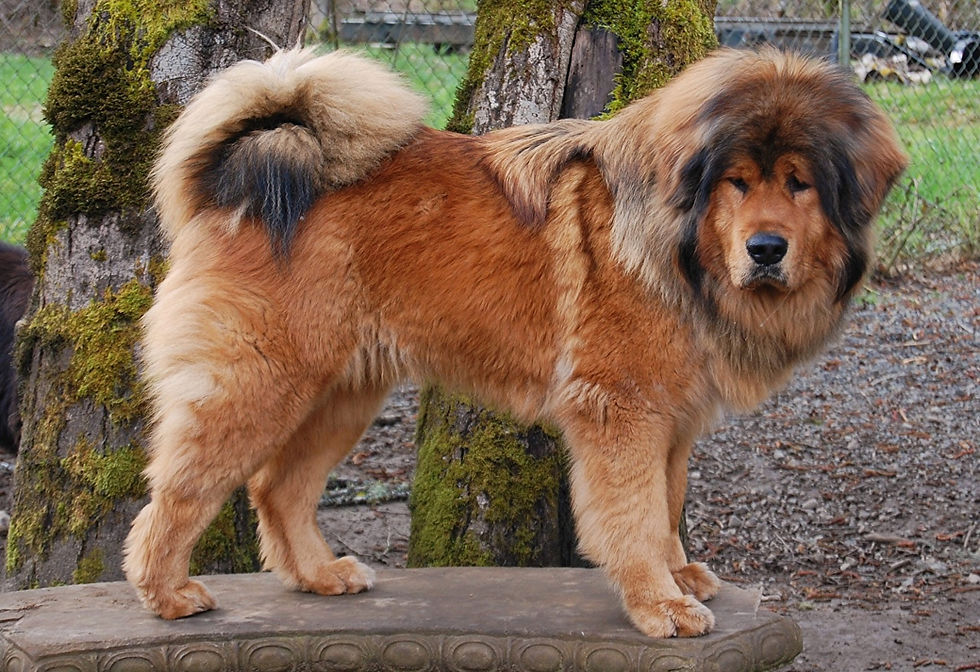Dogs from the Roof of the World
- Margaret James

- Mar 18, 2022
- 4 min read
This week we had a Tibetan Mastiff at our doggie daycare. That same day we had a Saint Bernard and a Bloodhound. The Tibetan Mastiff dwarfed them both. His shoulder came up nearly to my waist. His face had short fur, but then the rest of his body had long fur. The long fur began where a human would have a hairline. It made his face curiously undoglike. Tibetan Mastiffs are nicknamed lion dogs.

Tibetan Mastiffs are known to be gentle, sweet tempered dogs. The one we had in doggie daycare certainly was. Legend has it that they are all reincarnated lamas. I’m thinking that the ones who guard Buddhist temples are the ones who are reincarnated lamas. The ones who guard regular families must be reincarnated meditators. I think this idea is an attempt to explain their very calm temperaments. Placid as they normally are, they are fierce guardians of their human families. Historians guess that they have been guarding Tibetan tents and temples for over 16,000 years, making them one of the oldest breeds of dogs in the world. They are widely acknowledged to be the ancestral stock of most large mastiff-type dogs.

Tibet was closed to the West until the 1800s, and naturally closed to nearly everyone else due to their topography. The Chinese managed to see some Tibetan Mastiffs, though - they’re mentioned in Chinese travel histories from 1100 B.C.E.
Tibetan Mastiffs have different blood than all other dogs. Their hemoglobin contains two amino acid mutations that allow them to breathe at high altitude. The average elevation in Tibet is roughly 14,370 feet. The average. In the State of Colorado, we have only 58 “14ers” - mountains whose peaks are 14,000 or more feet above sea level.
Mount Everest's elevation is 29,032 feet. That’s just amazing to me. That’s more than twice as high as the 14ers that are so unusual here that they stand out from their surrounding ranges. No wonder people take oxygen tanks when they summit Mount Everest.
In any case, the Tibetan Mastiffs get their special blood from Tibetan Wolves, who carry the same genetic mutations.
Marco Polo (1254-1324) wrote about the Tibetan Mastiffs, saying that they were the size of a small donkey. His book, The Travels of Marco Polo, may be the first guidebook ever written. I’m curious now to order a copy.
The Viceroy of India gave Queen Victoria of England a Tibetan Mastiff as a gift, and that was the first time any of these dogs were seen in the West. The Kennel Club classified it as “Large Dog from Tibet”. Sheesh.
Two more Tibetan Mastiffs were brought to England in 1847 by the Prince of Wales (later King Edward VII - who was the grandfather of King Edward VIII, the one who abdicated to marry Wallis Simpson).
In 1928 four more Tibetan Mastiffs were brought to England by a man serving as Political Officer of Nepal and Tibet. His wife formed the Tibetan Breeds Association.
The first Tibetan Mastiffs in the United States (as far as can be determined by records) were a pair given to Dwight D. Eisenhower by the foreign ministry of Nepal. Apparently, Eisenhower was told he was being gifted Tibetan Terriers, which generally weigh 18-30 pounds - a good hundred pounds smaller than a Tibetan Mastiff. Eisenhower’s pair were shipped off to the Midwest and never heard from again.

The American Tibetan Mastiff Association was founded in 1966, and in the 1990s many more were imported to improve breeding.
Thousands of years of guarding humans, yaks, and temples have given the Tibetan Mastiffs a unique temperament. They will not chase a predator down. They simply want the predators to go away. They can be roused to fierce dramatic action, but as soon as the predators leave the Mastiffs’ territory, the dogs lie down and go back to sleep.
This week was apparently special poop week at work. I had a dog who pooped out chunks of hot orange, brilliant fuchsia, bright blue, and lime green. Each individual turd had big chunks of all four colors. But that was nothing compared to my colleague, who had a dog in her yard that pooped out an entire, intact, hot pink stegosaurus. She did not offer to return the toy dinosaur to the dog’s humans. She scooped it up with the poop scoop and put it in the poop can.
I can’t end this post without mentioning my cousin’s heart dog, Snoopy, who passed away this week after a long and happy life.

My cousin tells about the day the rescue people brought him to visit her. Snoopy was already a relatively old dog, who had just lost his human companion - an elderly woman. Jan says Snoopy took one look at her situation, and realized it was home. He knew what to do with an older woman! Jan and Snoopy were attached at the hip for the rest of his life. He could not have had a better human companion.





Yes! The other dachshund is Coco - my cousin adopted her . . . I can't remember when. You know, when I was in New Mexico I was always confused about the seasons because they don't really have winter there.
The dog licking its own face is a Tibetan terrier.
Snoopy has the face of a greyhound--so beautiful-- slender, soulful, sensitive. I'm hoping I have the right dog because I can't remember the dark-bodied dachshund's name. And is the dog licking his face a version of the Tibetan mastiff?
It's very disturbing to me to read that some people don't monitor what their dogs eat--to me it's criminal. Is there any way you can casually suggest they buy safer toys? Of course, accidents happen.
Listen to me, will ya? Our Sammy ate Bob's wallet and Emily, plastic red tumblers.
Signed,
Pot, calling the kettle black.